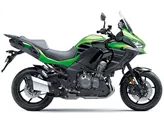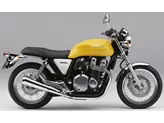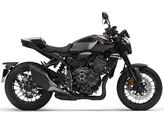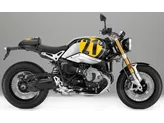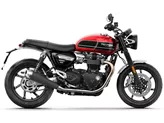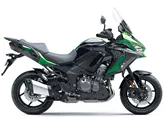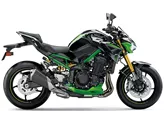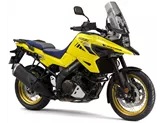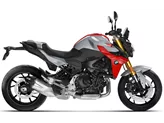Kawasaki Versys 1000 2016 vs. Kawasaki Z900 RS 2018

Kawasaki Versys 1000 2016

Kawasaki Z900 RS 2018
Overview - Kawasaki Versys 1000 2016 vs Kawasaki Z900 RS 2018
The Kawasaki Versys 1000 model year 2016 and the Kawasaki Z900 RS model year 2018 are both impressive motorcycles with their own unique features and strengths.
Starting with the Kawasaki Versys 1000 2016, it boasts a sporty look and a comfortable seating position, making it suitable for long rides. Its in-line four-cylinder engine delivers a powerful and refined performance, with an engine power of 120 HP and torque of 102 Nm. The adjustable windshield allows for customization based on the rider's preference. The chassis of the Versys 1000 is stable and provides a well-controlled braking system. Additionally, it offers a clever range of accessories and comes at a comparatively low price, making it an attractive option for riders.

Kawasaki Versys 1000 2016
On the other hand, the Kawasaki Z900 RS 2018 is known for its powerful and smooth engine, with an engine power of 111 HP and torque of 98.6 Nm. It also has a stylish design that appeals to many riders. The seating position is comfortable, and the bike is easy to ride with balanced handling. Unlike some other retro bikes in its class, the Z900 RS is not nervous or ponderous, providing a more enjoyable riding experience.

Kawasaki Z900 RS 2018
While the Versys 1000 has a few weaknesses, such as the windshield only being adjustable when stationary and the gear indicator costing extra, the Z900 RS also has its own drawbacks. It does not have a shift assistant, which can be a disadvantage for riders who prefer quick and seamless gear shifts. Additionally, the Z900 RS is slightly heavier than other retro bikes in its class, and the seat may feel a little too soft on long tours. Furthermore, it lacks wind protection, which can be a drawback for riders who frequently ride on highways or in windy conditions.
In conclusion, both the Kawasaki Versys 1000 2016 and the Kawasaki Z900 RS 2018 have their own strengths and weaknesses. The Versys 1000 offers a sporty look, comfortable seating position, and a powerful engine, while the Z900 RS boasts a smooth engine, good looks, and balanced handling. Ultimately, the choice between the two will depend on the rider's preferences and priorities.
Technical Specifications Kawasaki Versys 1000 2016 compared to Kawasaki Z900 RS 2018
Pros and Cons in comparison
Pros and Cons in comparison
Kawasaki Versys 1000 2016

The Kawasaki Versys 1000 is not a completely new model - even if it looks like one from the design point of view. The look has been cleverly adapted to the current aggressive Kawasaki line with two pointed headlights and many edges at the front. Technically, on the other hand, it has been cautiously upgraded - but quite sensibly. Two additional horsepower boost the output to 120 hp, which is excellent to ride thanks to the wonderful in-line four-cylinder characteristics. The chassis corresponds to the sporty demands of a Kawasaki, but the ergonomics and comfortable seating position allow for long journeys - just like a big enduro. With useful accessories such as a pannier set, top case, heated grips and additional headlights, the Versys 1000 becomes a serious long-distance tourer - the comparatively low base price makes these gimmicks quite affordable.
Kawasaki Z900 RS 2018

Its four-cylinder is silky smooth while delivering enough power to make you grin under your helmet. It is also very easy to move, which should make it a great commuter bike in everyday life and serve as an iconic fun bike at the weekend. The looks find the perfect straddle of classic design and modern details to form a coherent retro package that is also a worthy tribute to Kawasaki history. It's a great naked bike with a snazzy look.
Price Comparison Avarage Market Price Kawasaki Versys 1000 vs Kawasaki Z900 RS
There are a few key differences between a Kawasaki Versys 1000 2016 and a Kawasaki Z900 RS 2018. In terms of price, the actual average price of a Kawasaki Z900 RS 2018 is about 24% higher. A Kawasaki Versys 1000 2016 experiences a loss of 1,100 GBP in one year and 940 GBP in two years of ownership. This is offset by a loss of 910 GBP and 1,080 GBP for a Kawasaki Z900 RS 2018. Compared to Kawasaki Z900 RS 2018 there are less Kawasaki Versys 1000 2016 bikes available on the 1000PS.de Marketplace, specifically 7 compared to 28. It takes less time to sell a Kawasaki Versys 1000 with 88 days compared to 154 days for a Kawasaki Z900 RS. Since model year 2012 1000PS.de editors have written 19 reviews for the Kawasaki Versys 1000 and 26 reviews for the Kawasaki Z900 RS since model year 2018. The first review for the Kawasaki Versys 1000 was published on 07/11/2011 and now has more than 8,400 views. This compares to more than 63,700 views for the first review on Kawasaki Z900 RS published on 06/09/2017.



